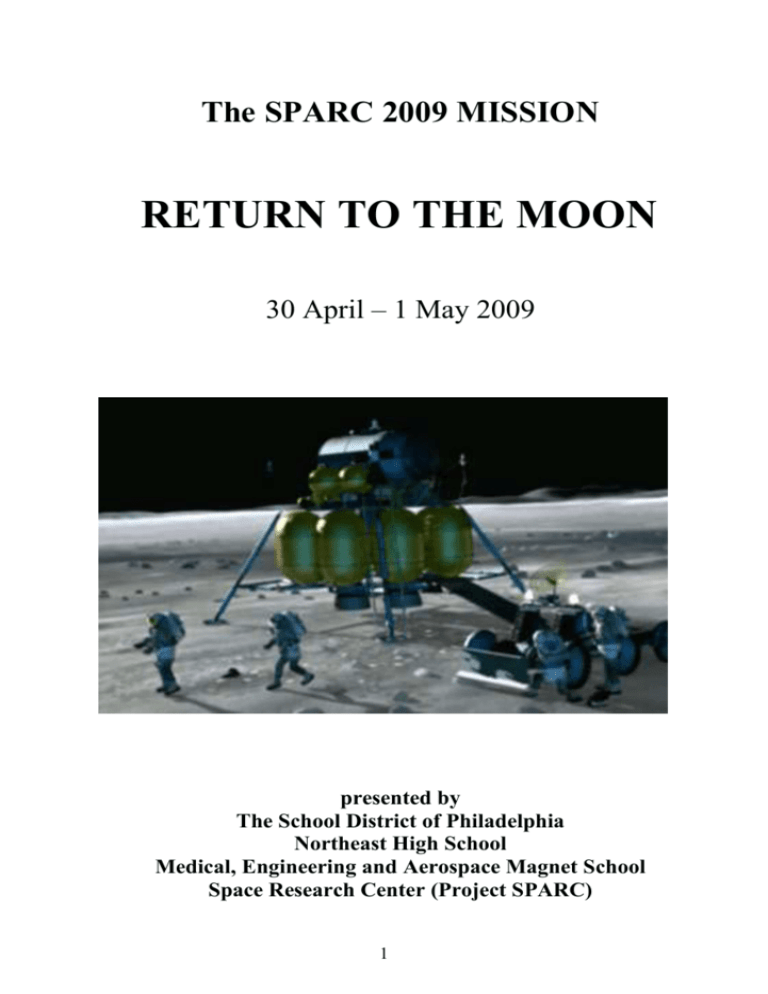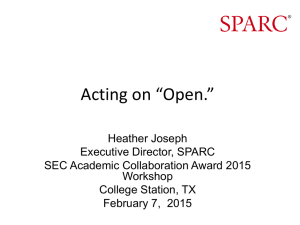Playbill - Northeast High School - The School District of Philadelphia
advertisement

The SPARC 2009 MISSION RETURN TO THE MOON 30 April – 1 May 2009 presented by The School District of Philadelphia Northeast High School Medical, Engineering and Aerospace Magnet School Space Research Center (Project SPARC) 1 DEDICATION IT IS WITH IMMEASURABLE GRATITUDE AND RESPECT THAT WE DEDICATE OUR FLIGHT TO THE FALLEN PHILADELPHIA POLICE OFFICERS. 2 The Fallen Police Officer Charles Cassidy –11/1/2007 Officer Cassidy had served with Philadelphia Police Department for 25 years. He is survived by his wife, Judy and three children, Katie, Nicole and son, John. Sergeant Stephen Liczbinski –5/3/2008 Sergeant Liczbinski had served with the Philadelphia Police Department for 12 years. He is survived by his wife, Michele and three children, Matt, Steve, Amber (a Northeast High junior). Police Officer Isabel Nazario – 9/5/2008 Police Officer Nazario has served with the Philadelphia Police Department for 18 years. She is survived by her daughter Jazmin, mother and a sister. Sergeant Patrick McDonald – 9/23/2008 Police Officer Patrick McDonald had served with the Philadelphia Police Department for eight years. He is survived by his father and mother and his sister. Sergeant Timothy Simpson – 11/17/2008 Sergeant Simpson had served with the Philadelphia Police Department 20 years and is survived by his wife, Cathy and three children, Courtney, Terry and Samantha. Police Officer John Pawlowski – 2/13/2009 Officer Pawlowski had served with the Philadelphia Police Department for 5 ½ years. He is survived by his expectant wife, Kimmy. 3 SPARC Project Staff Ms. Margaret Karpinski Director of SPARC and Magnet School Supervisor of Computer Group Ms. Anne Johnson Supervisor of Medical Group School Nurse Dr. Charles Gorbsky Science Department Head Supervisor of Engineering Group Physiology & A.P. Environmental Teacher Mr. James Lynch Spanish Teacher Flight Group Supervisor Air Force Captain & Leader of NEHS Civil Air Patrol Mr. David Seltzer Science Advisor US Army Research, Development & Engineering Center (retired) Ms. Carole Niemiec Robotics Advisor The School District of Philadelphia School Reform Commission Sandra Dungee Glenn – Chairwoman Denise McGregor Armbrister Martin G. Bednarek Heidi A. Remirez, Ph.D. 4 The Northeast High School Medical, Engineering and Aerospace Magnet School (www.nehs.phila.k12.pa.us/slc/magnet/magnet.htm) Students from all parts of the School District of Philadelphia student population compete to attend the Northeast High School Medical, Engineering and Aerospace Magnet School. The Magnet School Program provides a rigorous college preparatory program which attracts students with strong science and math aptitudes. The goal of the magnet school is to provide the education and that will engage the students and encourage them to pursuing careers in the medical fields, engineering, and the aerospace sciences. Student Managers and Members of Project SPARC Project SPARC (projectsparc.home.comcast.net) The Space Research Center (SPARC) an after-school activity of the Magnet School and NEHS. The Space Research Center was built and Project SPARC began in the early 1960s. The SPARC demonstration facilities include a 21 foot mock-up of a Shuttle Orbiter, an Apollo training capsule provided by NASA, eight mission control consoles, a Graphics and Visualization training center and robotics and electronics laboratories. The mission of project SPARC is to promote the development of leaders dedicated to the extension of mankind’s grasp beyond that of planet Earth 5 by educating students with interest in medical fields, computer sciences, electronics, engineering, flight management, and robotics. Project SPARC provides practical hands-on experience for students in their individual fields of interest. The teamwork and cooperation intrinsic to the success of the program reflect the maturity and personal development acquired by involved students. The Viking Altair (LSAM) Simulator At the end of each academic year, a simulated NASA mission is executed, lasting two days, and involving 140 students organized in 6 student-managed groups. The six groups are: Administrative, Flight Management, Computers and Automation, Engineering, Robotics and Medical. Apollo Training Capsule provided by NASA 6 The SPARC MISSION 2009 FLIGHT RETURN TO THE MOON The NASA Constellation Program Constellation is a NASA program with the stated goal of gaining significant experience in operating away from Earth's environment, developing technologies needed for opening the space frontier and conducting fundamental science. Constellation was developed through the Exploration Systems Architecture Study, which determined the best way for NASA to pursue the goals laid out in President George W. Bush's Vision for Space Exploration and the NASA Authorization Act of 2005. NASA plans to develop a host of spacecraft and booster vehicles in order to replace the Space Shuttle and return astronauts to the Moon and then possibly send them to Mars as well. Currently, NASA is in the process of designing two boosters, the Ares I and Ares V. Ares I will have the sole function of launching mission crews into orbit. Ares V will be designed to launch other hardware for use on missions and will have a heavier lift capacity than the Ares I booster. In addition to these two boosters, NASA is designing a set of other spacecraft for use during Constellation. These will include the Orion crew capsule, the Earth Departure Stage and the Altair lunar lander. Under this new Vision, the first robotic missions will be sent to the Moon as early as 2008 and the first human missions as early as 2015 to test new approaches, systems and operations for sustainable human and robotic missions to Mars and beyond. The Project SPARC Return to the Moon (continued page 13) 7 The SPARC MISSION 2009 FLIGHT RETURN TO THE MOON Day 1 Activity Schedule April 30 2009 Time 8:00 am 8:30 am 9:00 am 9:20 am 9:30 am 9:40 am 10:00 am 10:15 am 11:00 am 12:00 pm 1:00 pm 1:30 pm 2:00 pm 5:00 pm 7:00 pm 11: 00 pm Event Segment 1: Preflight Segment 2: Launch Video Teleconference Resume Countdown Lift Off OMS 1 Burn Segment 3: Orbit Payload Inspection Segment4: Leave Orbit Lunch Segment 5: Orbit with ISS Docking with ISS Segment 6: Install Module Dinner Day end checks Sleep and Guard shifts Meet the Astronauts Crew Exploration Vehicle / Command Ship Crew : Science Engineer – Crew Exploration Vehicle : Science Engineer – Crew Exploration Vehicle 8 The SPARC MISSION 2009 FLIGHT RETURN TO THE MOON Day 2 Activity Schedule May 1 2009 Time 7:30 am 8:00 am 9:00 am 10:00 am 10:30 am 12:00am 1:30 pm 2:00 pm 2:30 pm 2:45 pm Event Wake up Breakfast Module Checkout Segment 7: Undock De-Orbit from ISS Lunch Segment 8: Re Entry Segment 9: Approach Touchdown Debriefing Meet the Astronauts Viking Lunar Lander Crew : Commander – Viking Lunar Lander : Pilot – Viking Lunar Lander : Payload Specialist – Viking Lunar Lander : Mission Specialist – Viking Lunar Lander 9 PROJECT SPARC STUDENT MANAGERS The following student managers are essential to the foundation of Project SPARC. Their dedication and commitment to the program has made this simulation possible. They provide guidance, leadership and peer-to-peer training to their fellow students. They, along with SPARC’s many members, have devoted numerous after school hours to ensure a successful space flight. Each student listed has earned the respect and admiration of the entire SPARC staff and team for their dedication to our program. SPARC President: Administration Manager: Computer and Automation Managers: Engineering Manager: Flight Management Manager: Medical Managers: Robotics Managers: Michael Behr Wendy La Peter Lee, Michael Behr Jun Lee Abishek Patel Rona Farighi & Eman Haj Richard Lazarus, Ashleigh Niemiec Launch Control Crew in the Mission Control Center 10 Administration Manager: Wendy La The Administrative Group provides support to ensure a successful year for the Magnet and SPARC Programs. Members are responsible for coordination with sponsors and donors, NASA and the media. They write the press releases and the "Magnetic News", the student-written magazine distributed to all Northeast Magnet students. They also write agendas, record attendance at SPARC meetings and weekly group activities, maintain the calendar of events, create this playbill, send out invitations for the flight, and handle any other necessary preparations. The Admin Group coordinates student activity so that all SPARC members are present for, and have an active role in the annual flight. Computers and Automation Managers: Peter Lee, Michael Behr The Computers and Automation Group maintains and operates the SPARC Local Area Network and server, the SPARC website, the mission and flight simulators, video teleconferencing with NASA and the software and operating systems of the Mission Control, Learning Center and space vehicle computer systems. The group also captures, edits and produces movie clips to support the flight including virtual models in Google Earth Pro and green screen special effects for virtual launch sequences and background scenes for TV and media reporters. Engineering Manager: Jun Lee The Engineering Group manages, maintains and upgrades the SPARC facilities and their assets. This includes the SPARC entrance hallway and its exhibits, the Shuttle and Apollo Capsule rooms with their space vehicles, mission consoles, cameras and the training center as well as the Electronics, Engineering and Robotics laboratories. During the flight, Engineering is responsible for operating the Audio/Visual Mission Consoles and queuing all movies, cameras and A/V effects. Engineering is also tasked with bringing the facilities up-to-date with the new NASA Mission for The Earth, Moon, Mars and Beyond. 11 Flight Management Manager: Abishek Patel The annual simulated flight is the combined effort of all SPARC groups and members. Flight Management creates and develops the flight plan and script for the annual mission. They coordinate and integrate the efforts of the other SPARC groups into the annual flight presentation and implement the script dialog, activities and event queuing on the local internet for display on all Mission Consoles. Flight Management also trains the astronauts, Flight Directors and Mission Control operators in their roles and activities during the flight. Medical Managers: The SPARC Medical Group trains in and receives CPR and First Aid certification. They learn about the effects of space travel on the body, how the body is affected by spaceflight and the potential problems and side effects of space flight. During the annual flight the Medical Group observes, monitors and performs evaluations and tests on the astronauts. An annual tradition with the Medical Group is an unscripted medical emergency during the flight which the astronauts and ground crew must cope with. Robotics Managers: Richard Lazarus, Ashleigh Niemiec The Robotics Group participates in a variety of robotic competitions during the school year and brings facets of these competitions to the annual flight. The Robotics Land Systems team uses equipment created by LEGO and MINDSTORMS, to build various robots for city-wide competitions held throughout the year. The Robotics Sea Systems team develop and build robotic submarines to participate in the annual US Navy/Drexel University “Sea Perch” competition. Both robotics teams build simulations for the flight that may depict operations that may occur during the flight. The new Engineering and Robotics Laboratory provides a unique aquatic testing and training facility which is envisioned to be shared with other Philadelphia schools in the area. 12 Forty Six Years of Space Flight at Northeast High School In January 1960 physics teacher Robert A. G. Montgomery was asking – how might we build a space capsule backstage in Morrison Hall. By 1962 the project had been formulated, approved and had local and national media visibility. The project was founded on two rules, “First,” said Mr. Montgomery, SPARC’s founder and first director, “never discard any ideas. Secondly, the group’s adult technical advisors are not permitted to suggest new ideas. Everything must come from the students.” Phase 1 began in 1962 with a call for 50 students who were interested in space and a budget of $200. It included scientific research by students into the many and varied problems of space life. Phase 2 began in January of 1963 with the construction of the 318 square foot System Evaluation Facility behind the school auditorium, Morrison Hall. Plan for the System Evaluation Facility Phase 3: Conduct Simulated Tests and Evaluation, initiated testing with in what was originally called the Space Research Capsule or Operation SPARC. Project SPARC was recognized by NASA as first High School space program in the united states. In Sept 1963, 18 students accepted NASA’s invitation to tour Huntsville, Cape Kennedy, Goddard and Houston. Project SPARC has been visited by such astronauts as Scott Carpenter, Guy Bluford and Chris Ferguson. Captain Chris Ferguson has served as our honorary Flight Director in 2007 and 2008 with video teleconferences from the Johnson Space Center in Houston. 13 Astronaut Command pilot Warren Kurnick, 16, Pilot Lewis Hersch and Engineer Donald Nibouar completely sealed in the12 1/2 foot diameter Apollo simulator for 121.5 hours(five days) May 17th 1966 The Aerospace Wing and Apollo Capsule were added to Northeast High School in 1969. Project SPARC simulated space capsule was reborn in a trailer behind the aerospace wing in 1976. The Viking I Shuttle Orbiter was built and flown in 1983. The current Viking Shuttle Orbiter was built in 2003. SPARC Directors: Robert A. G. Montgomery Gerald Mayall Antony Matarazzo Margaret Karpinski 1962-1982 1982-1991 1991-2005 2005-present SPARC Today : Ms. Margaret Karpinski assumed directorship of the Magnet School and Project SPARC in July 2005 with the goal of aligning the program with NASA’s new vision called “The Earth, Moon, Mars and Beyond”. Phase 1 of this effort is the refurbishment of the SPARC equipment and facilities and the addition of the Learning Center and the Engineering and Robotics Laboratory. 14 The objectives of Phase 2 will include documentation of SPARC practices and procedures and the sharing of SPARC methods and facilities with other educational and learning centers. In March 2008 the Graphics and Visualization Training Center was added to the SPARC facility as a means to introduce student peer training of film making and the development of virtual environments. The new Graphics and Visualization Training Center with software provided by a grant from Google Earth The goal of the 2009 flight is to simulate NASA’s new mission under the Constellation Program. This simulation will include a dual Ares rocket launch, docking, travel to the moon, landing on the Lunar surface, assembling a notional Lunar habitat, ascent and return to Earth. The Ares cargo and crew rockets will leave the Northeast High School softball and football fields respectively and the Crew Exploration Vehicle (capsule) will land in the school soccer fields. 2009 Viking Virtual Launch Vehicles Ready on the NEHS Sports Fields 15 SPONSORS The SPARC Project and Northeast High School would like to thank and show our appreciation to the companies and organizations who have supported this program with their generous contributions. The School District of Philadelphia School Reform Commission Northeast High School Ms. Linda Carroll, Principal U.S. Army Communications-Electronics Center Fort Monmouth, New Jersey Mr. David Seltzer The Home Depot 11725 Bustleton Ave. Ms. Maureen Marinucci, Manager LOWE’S of N.E. Philadelphia 9701 Roosevelt Boulevard Mr. Dave Swiger, Manager QuickTime™ and a TIFF (LZW) decompressor are needed to see this picture. 1713 Grant Ave. Philadelphia, PA 19115 Ms. Melissa Borschell, Manager 9745 Roosevelt Blvd Philadelphia PA 19114 Mr. Kevin Marsh, Manager 16








